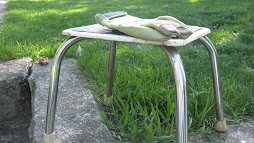



 Uh oh...trouble. And I have hardly planted anything yet!!
Uh oh...trouble. And I have hardly planted anything yet!!
Tyro - Pronunciation: \ˈtī-(ˌ)rō\ noun Medieval Latin, from Latin tiro, tyro. A beginner in learning: novice. Synonyms: see amateur. Yes. That would be me...

 See my new rain gauge? We had over half an inch this week. I learned at the Bosler Library Master Gardeners presentation (again, thanks Duane!) that an inch of rain a week is good. I also added string to the rest of the gardens to delineate the squares for planting purposes.
See my new rain gauge? We had over half an inch this week. I learned at the Bosler Library Master Gardeners presentation (again, thanks Duane!) that an inch of rain a week is good. I also added string to the rest of the gardens to delineate the squares for planting purposes.


 I am taking a gardening class for beginners at the wonderful Hope Station given by the amazing Master Gardeners in our area. They gave us onion sets (Thanks, Ann) my 80-ish neighbor calls, "stick 'ems". I have had to RE-stick 'em twice because the squirrels did a roto-rooter on the square. Squirrels...
I am taking a gardening class for beginners at the wonderful Hope Station given by the amazing Master Gardeners in our area. They gave us onion sets (Thanks, Ann) my 80-ish neighbor calls, "stick 'ems". I have had to RE-stick 'em twice because the squirrels did a roto-rooter on the square. Squirrels...




